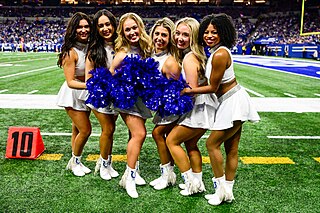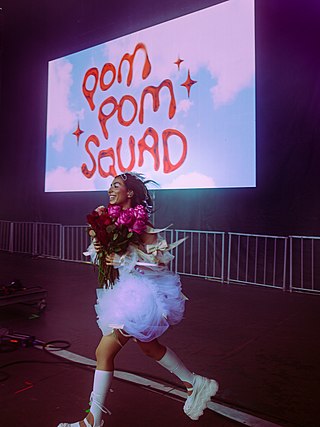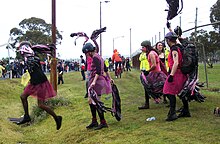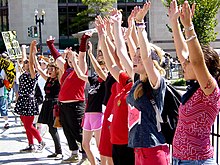
Cheerleading is an activity in which the participants cheer for their team as a form of encouragement. It can range from chanting slogans to intense physical activity. It can be performed to motivate sports teams, to entertain the audience, or for competition. Cheerleading routines typically range anywhere from one to three minutes, and contain components of tumbling, dance, jumps, cheers, and stunting. Cheerleading originated in the United States, where it has become a tradition. It is less prevalent in the rest of the world, except via its association with American sports or organized cheerleading contests.

A protest is a public act of objection, disapproval or dissent against political advantage. Protests can be thought of as acts of cooperation in which numerous people cooperate by attending, and share the potential costs and risks of doing so. Protests can take many different forms, from individual statements to mass political demonstrations. Protesters may organize a protest as a way of publicly making their opinions heard in an attempt to influence public opinion or government policy, or they may undertake direct action in an attempt to enact desired changes themselves. When protests are part of a systematic and peaceful nonviolent campaign to achieve a particular objective, and involve the use of pressure as well as persuasion, they go beyond mere protest and may be better described as civil resistance or nonviolent resistance.

Bring It On is a 2000 American teen comedy film directed by Peyton Reed and written by Jessica Bendinger. The film stars Kirsten Dunst, Eliza Dushku, Jesse Bradford and Gabrielle Union. The plot of the film centers around two high school cheerleading teams' preparation for a national competition.

The Dallas Cowboys Cheerleaders are the National Football League cheerleading squad representing the Dallas Cowboys team.
A dance squad or dance team, sometimes called a pom squad or song team, is a team that participates in competitive dance. A dance squad can also include: a jazz squad, ballet squad, or any kind of religion dance squad. Dance squads are a type of performance dance.
Dallas Cowboys Cheerleaders: Making the Team is an American reality television series that aired on CMT from September 29, 2006, to November 27, 2021. The series follows the auditioning process and the forming of the Dallas Cowboys' annual Cheerleading squad. The series features director Kelli McGonagill Finglass and choreographer Judy Trammell.

The Buffalo Jills were the cheerleading squad for the Buffalo Bills professional American football team.

National Football League Cheerleading or simply NFL Cheerleading, is a group of professional cheerleading organizations in the United States. 24 of the 32 NFL teams include a cheerleading squad in their franchise. In 1954, the Baltimore Colts became the first NFL team to have cheerleaders. They were part of Baltimore's Marching Colts.
The University of Minnesota Golden Gophers Spirit Squads comprise the cheerleading organization at the Twin Cities campus of the University of Minnesota. Being the first program ever to form worldwide, the University of Minnesota is consequently considered the "Birthplace of Cheerleading". Today, the Gopher Spirit Squads consist of four separate squads: a cheer squad, a dance team, a hockey cheer squad, and the school's mascot, Goldy Gopher. The squads consistently perform well at national competitions including 21 national championships in dance since 2003, a 2nd-place finish for All-Girl in 2013, a fifth-place finish in 2017, and four-time national champion Goldy Gopher in 2011, 2013, 2017, and 2018. The current head coach is Sam Owens.
The University of Kentucky cheerleading squad represents the University of Kentucky in Lexington, Kentucky. It was founded in 1905 and its first cheerleaders were yell leaders who were usually male. University of Kentucky's first coed squad began in 1938, consisting of four males and four females. The coed squad became the norm in the late 60s, early 70s. T. Lynn Williamson was the cheerleading advisor from 1978 until his retirement in 2020. Williamson oversaw the program and brought in coaches to help build and advance the cheerleading program. Willimason's role encouraged Dale Baldwin to attend the University of Kentucky, who was a member of the University of Kentucky Cheerleading squad when the team won its first national championship in 1985. The University of Kentucky cheerleading squad has won the Universal Cheerleaders Association National College Cheerleading Championship twenty-four times.

Cheerleading is a sport that is practised all throughout the world, with increasing popularity within the United Kingdom. Cheerleading has over 89,000 athletes within the United Kingdom, with just over 900 teams in England alone, with the newfound success and passion of UK based teams on the international stage helping to change perceptions within the region. Teams from the United Kingdom have gained international recognition, with the Olympic Channel producing a 10 minute short documentary following Unity Allstars' team Ruby to highlight the increase momentum of competitive cheerleading within the United Kingdom.
Lawrence Russell Herkimer was an American innovator in the field of cheerleading. He created the Herkie cheerleading jump, which was named after him, and received a patent for the pom-pom. Herkimer described his contribution to the field as taking it "from the raccoon coat and pennant to greater heights".
The US National Cheerleaders Association (NCA) was established as a way to bring cheerleaders together to learn new skills. Since 1951, the NCA has held summer camps, and is credited with the invention of the herkie jump, the pom-pom, the spirit stick and being the first uniform manufacturer.

A pom-pom – also spelled pom-pon, pompom or pompon – is a decorative ball or tuft of fibrous material.
Memphis Pom is a collegiate dance team from the University of Memphis. The team has won 15 national titles.

The Miami Dolphins Cheerleaders is the professional cheerleading squad of the Miami Dolphins of the National Football League. The squad performs a variety of dance moves at the Hard Rock Stadium, the home stadium of the Dolphins. The Dolphins Cheerleaders released an annual swimsuit calendar every year. The squad hosts auditions every May. Like most other squads in the league, the MDC also has a youth cheer squad and help mentor young girls in the Miami area. The squad also makes USO trips. Every year, the MDC sends a cheerleader to the Pro Bowl. The MDC also sends a number of alumni to the Indian Premier League every year.
Laura Lynette Vikmanis is an American dietitian, personal trainer, and dancer who was a professional cheerleader for the Cincinnati Ben–Gals, the cheerleading squad of the Cincinnati Bengals. She was the oldest cheerleader in National Football League history, at 40 years of age when she joined in 2009. She is also a co-author of the book It's Not About the Pom-Poms.

Poms is a 2019 American comedy film directed by Zara Hayes, starring Diane Keaton, Jacki Weaver, Pam Grier, Celia Weston, Alisha Boe, Phyllis Somerville, Charlie Tahan, Bruce McGill, and Rhea Perlman. The film follows a group of women from a retirement community who decide to start a cheerleading squad. It was theatrically released in North America on May 10, 2019, by STX Entertainment.

Cheer is an American sport television docuseries airing on Netflix starting in January 2020. The six-part series follows the nationally ranked forty-member Navarro College Bulldogs Cheer Team from Corsicana, Texas, under the direction of coach Monica Aldama, as they prepare to compete in the National Cheerleading Championship held annually in Daytona Beach, Florida. The episodes focus especially on five individual Cheer Team members and include elements of the history of cheerleading, including the formation of the National Cheerleaders Association (NCA).

Pom Pom Squad is an American indie rock/grunge band from Brooklyn, New York. It is the solo project of frontwoman Mia Berrin, and features permanent members Shelby Keller (drums) and Alex Mercuri (guitar).














